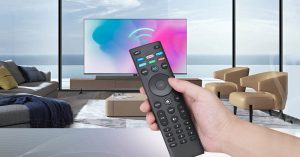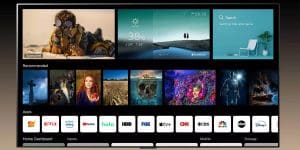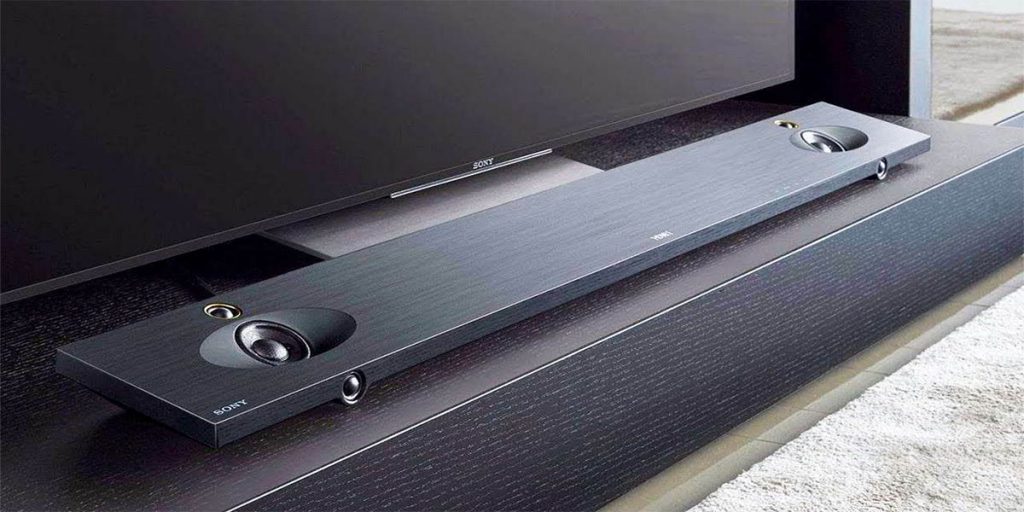What is a Home Theatre Power Manager
Home Theatre Power Managers, aka, power conditioners, help protect the home theatre from a power surge and spike by regulating the AC power to the devices and reducing noise by performing filtration of dirty current.
You can plug all the devices into the conditioner, which will regulate the power distribution to all the devices and prevent power spikes during power surges, which otherwise may damage multiple expensive and sensitive home theatre components.
Table of Contents
ToggleWhat It Is
A great place to start would be to answer, “What is a home theater manager?” You might also see them called another name, that being a “home theater power conditioner.”
The term “power manager” and “power conditioner” are the same, and are used interchangeably.
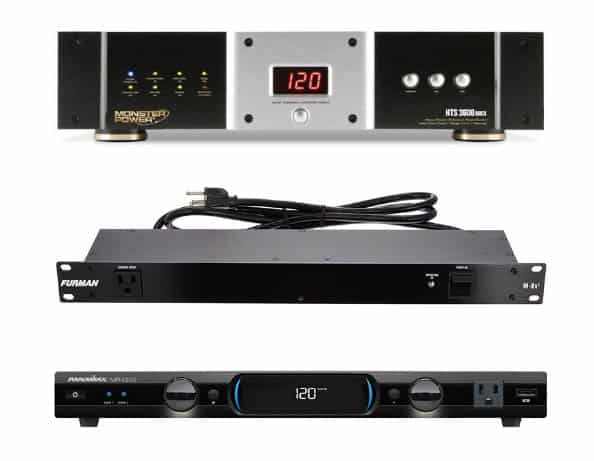
These devices look like a set-top box or a Blu-ray player, they’re designed to be mounted on a rack and have multiple outlets on the rear panel.
The front panel of the manager usually has a small screen to show the current voltage and a few other features depending on the model. Most models include a power switch too, which will cut off all the outlets.
High-end power conditioners are large and bulky, often weighing 50 lbs or more, making them pretty inconvenient for many home theatres. Not to mention they’re also very expensive, costing upwards of $5,000.
Essentially they are a special type of power board with multiple sockets to plug all your sensitive home theater equipment into. So, how does a theater power manager work? They can offer surge protection and filtration by regulating the AC distribution.
Overall features, including the level of protection and quality of filtration, will vary with the price. At the very minimum, you will receive improved electricity quality, correct distribution along with protection for an extended lifespan of your equipment.
Most home theatre power managers provide surge protection, noise filtration, and even automatic voltage regulators.
Small fluctuations and spikes in electricity flow can damage your equipment internally when your runs through your home theater. A conditioner filters this, therefore acting as a protector to your equipment connected to it.
A home theatre power manager protects your home theater system from surges. It can increase the quality of electricity and decrease disturbances. Unlike surge protectors, home theater managers offer a higher level of protection and faster response times.
A home theater power manager or conditioner is necessary to protect your home theater system from fluctuations and spikes in electricity flow. These managers filter the dirty AC, keeping your home theater systems protected and safe, allowing them to serve you for an extended period.
Do I Need a Home Theater Power Manager?
You won’t need to worry about voltage surges, lightning strikes, or dirty AC with one of these devices.
Given the sizable investment you will have made towards all your home theater components, it makes sense to protect them.
Even with freshly wired homes, current supplies can always be unpredictable, and protection isn’t the only benefit offered either.
Yes, we do need a home theatre power manager. It is a necessity. Owning a home theatre manager guarantees the protection of your home theatre from lightning strikes, power surges, and dirty current.
A few people may not need them, but this is all dependent on the quality of the electrical installations at home.
To ensure the long life and healthy functioning of their home theater equipment, users should opt for home theater power managers or conditioners.
A home theater system is made up of multiple pieces of equipment, all costing you a fair bit. It could be an expensive subwoofer, an expensive speaker set, or an expensive receiver. It is in the best interest of users to use a power manager or conditioner to protect this expensive electrical equipment.
A power manager is not necessary for home theatres unless you’re hearing noise or interference from the speakers.
Most people will connect their home theatre to a power manager for cable management, electrical protection, and to reduce line noise.
For a lot of electronics, a power manager is not needed because modern devices have built-in power supplies and chips that regulate, a slight change in voltage won’t normally create any problems.
In other words, most of your equipment will work just fine when connected straight to an outlet.
PCs have power supplies that have power filtering and other voltage regulating features, so a power conditioner is not required for computers and other electronics.
It won’t hurt to connect them to a power conditioner, but it might not make that much of a difference.
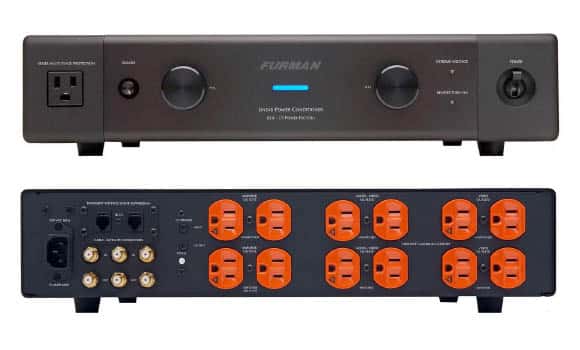
Easy Cable Management
The most useful feature of a power conditioner is how much it helps with cable management. Power conditioners are designed to be mounted in a rack and usually have eight outlets.
You can plug multiple devices into a power conditioner and switch them on or off when needed. For instance, you can connect your home theatre speakers, subwoofer, and even TV, to the same power conditioner.
Power conditioner also has built-in surge protection, so it’s an easy way to keep your electronics safe from electrical surges. The surge protection combined with electricity filters keeps your electronics safe.
What Does a Power Manager Do?
The purpose of a power manager is to not only keep your electronics safe but to also make sure only clean energy is entering the devices.
Power conditioners are usually used in audio-related setups because audio is more sensitive to noise and interference.
Dirty power and power irregularities cause irreversible malfunction and damage and decrease the performance of your home theater.
Depending on the model, they can improve the quality of your electricity and protect your electronics. These devices are worth the money as they protect your expensive home theatre system and ensure a longer lifespan.
These devices protect your TV and other electronics from electrical surges and provide premium quality protection. If you have a home theater system, you may want to consider investing in a power surge protector.
While a surge protector may protect your equipment, a power manager may prevent power surges from harming your electronics.
A power manager protects your devices from these hazards, and it can prolong their lifespan. The use of a power manager is especially helpful for devices that are always on.
In addition, they protect electrical equipment from damage caused by electrical surges and spikes. This is especially important if you live in an area where power outages are frequent.
Using a power manager to protect your expensive electronics is important. You might have many gadgets plugged into the same outlet, including your home theatre, so you want to be sure to protect them.
In addition, you may be an audiophile, and you value the quality of your sound and opportunities to eliminate background noise. A power manager will protect your electronics and improve the quality of your home theater.
A power manager is similar to a surge protector but is far more efficient. The surge protector diverts excess power from your circuit, but a manager cleans dirty power and eliminates noise.
Unlike surge protectors, the power manager disconnects your devices when high voltage is detected. In addition to it, the manager eliminates noises and cleans dirty AC to maximize the performance of connected devices.
Effect of the Power Manager on Sound Quality
When it comes to speakers, some power managers filter too much noise and cut out some of the dynamic range in your audio signals.
If you have the option, I would test the audio quality using a manager vs using the mains. For some, the audio from the mains’ power is more dynamic and rich while the manager is flatter.
However, the results will depend on the power conditioner model you use, and the quality of your mains electricity. If your electrical line has a lot of noise, a power manager will likely improve the audio quality.
Just looking to improve audio? An expensive manager probably won’t improve the audio quality of your home theatre.
They can subtly muffle the dynamic range of your speakers, but it varies depending on several factors.
Even though they don’t deny that power conditioners can protect your equipment, many audiophiles question their effect on the overall performance of your audio setup. They argue that conditioners can reduce or eliminate the noise (dirty AC), but they can also remove some of the sounds they are not supposed to. As a result, the audio reproduction loses some dynamics and becomes lifeless, that most power conditioners tend to ‘’rob the music of its life and bleach the sound’’.
Suggests using power regenerators. We’re not denying that power regenerators are great, but they are also quite expensive. Some of them are much more expensive than the average power conditioner.
But what to do if you can’t afford such an expensive device? Is there some other solution? Well, there’s one thing many audiophiles and home theater enthusiasts do. They install a dedicated line (or rather pay a professional electrician to do that) and add an outlet that’s going to be used for your audio equipment only.
Most of the power outlets in your (and any other) home in the US share power with refrigerators, routers, microwaves, lightbulbs, and many other appliances. All these appliances can introduce noise and affect the performance of your home theater system. Adding a dedicated line for your home theater (or just for your amplifier/AVR) can eliminate that noise. That way, you will get much cleaner power and cleaner sound without adding a conditioner, and you won’t compromise the performance.
The problem with a dedicated line is that, even though it can eliminate the noise and increase the efficiency of the power supply, it can’t protect your equipment from power surges or from under and overvoltages. For that, you still need at least a surge protector (preferably a power manager).
What Creates Dirty AC?
Dirty power is the current that contains high-frequency noise, voltage spikes, lightning surges, and power surges. Dirty AC makes it difficult for sensitive devices in your home theater equipment to operate properly.
Dirty current results from the electrical noise of AC outlets, which can cause problems in sensitive electronics such as home theatre devices.
Electricity coming from the wall outlet is polluted over time by electromagnetic fields from the surrounding environment.
These fields are produced by everything from lights to microwaves and electrical lines, electrical motors, and other appliances.
The result is a lower quality of energy that can damage, degrade and disrupt the operation of sensitive electronic devices such as home theatre systems.
This is not just a problem for home theatre systems, but for any device plugged into the electrical outlets.
Most electronic devices are not protected against noise, and most home theatre systems are not protected against dirty power.
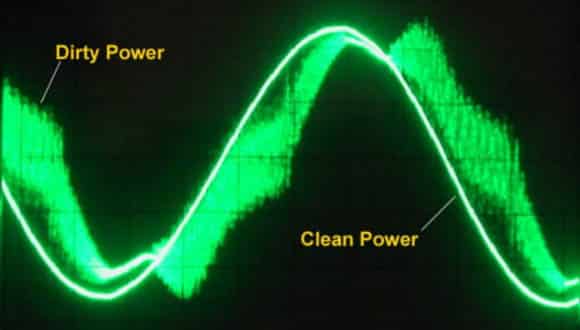
Dirty power is the result of anomalies in the power supply. Some examples of dirty current are voltage variations, power surges, and mode noise. While voltage variations and surges pose a risk of damaging your equipment, mode noise can affect performance quality.
Mode noise is a low-level signal, which, if not filtered out, can often be heard through your speakers as pops or hums. So, what causes mode noise? It can often be detected when other devices are used, such as turning lights on and off or switching on the microwave.
One of the main causes of noise in electricity is actually from other electronics connected to the same circuit in your home.
Most modern electronics convert AC from the mains to DC using switching power supplies that quickly convert AC electricity but also send noise back into the circuit.
The noise can also be introduced by your neighbors, weather, radio waves, EMFs, and many other factors.
Dirty electricity is another term used for electricity that is unreliable or has a lot of noise. There are a lot of factors to consider, such as micro-surges, signal interference, damage to the power grid, line noise, and many others.
Dirty energy can also create electromagnetic fields (EMFs) that can interfere with electronics.
The Difference Between a Power Conditioner and a Surge Protector
Surge protectors and power managers/conditioners have some features in common but are not the same devices.
Surge protectors, as the name implies, protect your equipment from surges. That’s pretty much all they do.
Surge protectors usually use a semiconductor called MOV (Metal Oxide Varistor) and gas discharge arrestors. Thanks to these components, surge protectors can divert excess energy from your equipment to the grounding wires.
The problem with surge protectors is that your equipment never gets disconnected from the circuit. In other words, your equipment relies on the surge protector to divert as much energy as possible.
But what happens if a very high voltage event occurs (like a lightning)? Your surge protector may absorb too much energy, it could explode, and could kill your equipment in the process. All that is because surge protectors can’t disconnect your equipment when a high-voltage event happens.
On the other hand, most power managers use the EVS or Extreme Voltage Shutdown technology. The EVS has a mechanical relay that physically disconnects your equipment when a high-voltage event is detected. EVS acts very quickly and doesn’t even sacrifice the manager.
So, power managers, just like surge protectors, protect against surges, but in a different, some would say safer way.
Besides that, managers have other purposes.
- They have filters that can remove the noise and deliver cleaner AC to your equipment, which will result in a cleaner sound.
- Furthermore, some managers will protect your equipment from the under-voltage event – when the voltage drops below 80 or 85V, it will shut down the unit and protect your equipment from too much current.
- Also, home theater managers may have better specs than surge protectors (lower clamping voltages, lower response times).
To conclude, power managers or conditioners are more complex devices. They offer more protection than surge protectors and also have some additional features and purposes.
How Much Should I Spend?
The price of home theater power managers and conditioners varies a lot. Budget units are priced around $100-$150. Some cheap units under $50 are advertised as conditioners, but they are just surging protectors.
If you want a well-performing conditioner that filters the noise and protects your equipment, you should spend at least $300. If that’s too much for you, buy something cheaper – any protection is better than no protection.
Have in mind that cheaper power conditioners will provide the protection you need, but their noise filtration capabilities won’t be great. If you don’t have any problems with dirty current, buying a cheaper unit is a perfectly viable option.
The prices of high-end units for professional use can reach $5,000 or more, but you don’t have to spend that much. You can get a great-performing conditioner that will protect all of your home theater equipment and isolate most of the noise for $500-$1000.
Best Home Theatre Power Managers in 2022
As with any ranking, much depends on personal preference. You may find other companies and models of power conditioners ranked as the best on other sites. But all of these models featured here are noteworthy and trustworthy.
1 Panamax MR5100
This is a compact unit that can be rack-mounted. There are three indicators on the left side of the front panel to monitor the three power supplies. In the center is a screen where you can monitor output voltage and faults. There are lightning and socket indicators for this purpose. There is a USB socket for charging phones, located on the right side, and one socket next to it.
On the back panel there are 10 outlets in three blocks, this separation into blocks prevents mutual interference and interference. All 11 outlets (10 in the back and 1 in the front) are powered after LiFT filtering. All outlets have surge protection.
This dispenser has 2 coaxial inputs and outputs each, LAN input and output, and telephone input and output.
Single pulse energy dissipation: 2025 Joules. Response time: 1 ns. Automatic voltage monitoring (AVM).
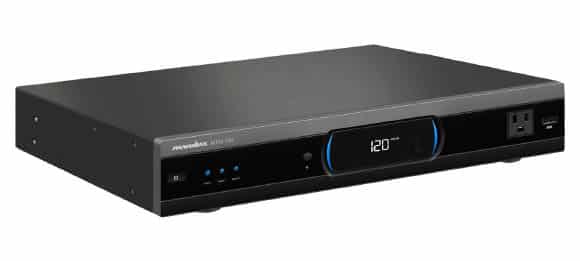
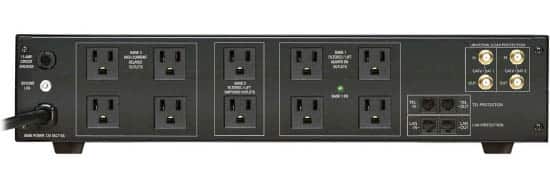
2 Panamax MR4300
One of the best for all occasions and various equipment. It has 9 sockets per output with filtering and protection. Exclusive Automatic Voltage Monitoring (AVM). Linear Level 3 Filtration (2 Total Isolated banks) with Dedicated High Current Outlet Bank (4 Outlets).
It has a USB port for charging mobile devices. It also includes a 15 amp circuit breaker. Response Time: 1ns. Lifetime warranty available. Single Pulse Energy Dissipation: 1575 Joules.

3 Furman PL-8C 15 Amp
Dispenser for 9 outlets. Total power 15 amps. Furman SMP and LiFT protection and filtering technology. The design of the entire device, the functional scheme, and the set of protections and filters put this power manager in the section of the best.
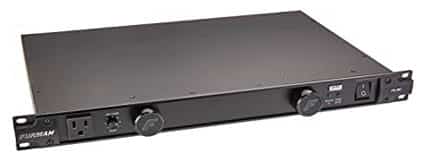
4 Furman M-8×2 Merit X Series
Built-in 15 amp circuit breaker. Nine AC mains outlets. EMI/RFI noise filtering.
The Furman M-8X2 also helps in noise reduction. The AC noise filtering reduces RFI/EMI. It helps to filter the power and supply a clean current to your home theater. This device protects against power spikes and surges.
It comes with a 15 amp rated circuit breaker. There is a front panel indicator in this device that helps you to know that your system is protected. The “Protection OK” indicator shows that your equipment is being protected.
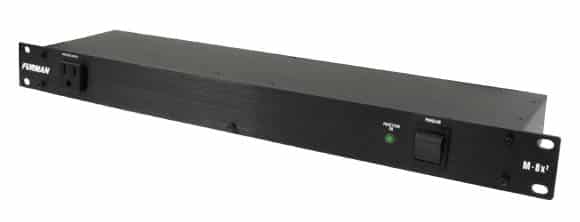
5 AudioQuest Niagara 1200
AudioQuest products are praised for their quality of audio equipment. And the Niagara 1200 power conditioner is a premium product for lovers of quality audio. It has 5+2 outlets, two of which are designed for high current (for amplifiers), and 5 line outlets with filters. These are designed for audio systems but will work well for home theater as well.
All inputs and outputs are made from AudioQuest’s high-quality NRZ silver and beryllium series.
The Niagara 1200 is capable of ultra-quiet operation with very low noise levels.
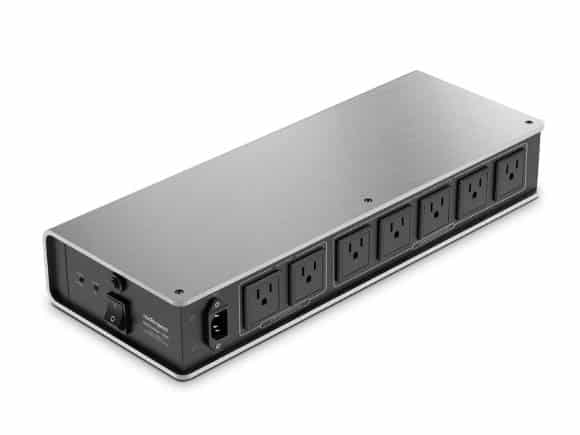
FAQ
Are there enough outlets?
While it is possible to add daisy chain power managers or plug in a surge protector to increase the number of outlets, this isn’t advised. You need to remember that all of these devices are being run off a single wall outlet, and they could become overloaded.
If you do require additional outlets, I would advise you to plug your other manager or surge protector into a separate wall outlet. For even better results, try to plug them into outlets that are on two separate breakers.
Can power managers be used for other appliances?
You can certainly use a manager for appliances and devices other than home theater equipment. They can be especially handy for use around an office desk. Protect your computer, printer, modem, router, and any other computer accessories.
They aren’t limited to electronic equipment either. You can plug anything into a manager that is usually plugged into a wall outlet.
Will a UPS do the same thing?
A manager and a UPS (Uninterrupted Power Supply) are completely different. The UPS has a battery backup which will give you enough time to shut down your devices correctly during an emergency.
A power manager will cut current immediately during an emergency, which is still much better than risking major damage to your equipment. You can, of course, combine both of these products for the ultimate safety and protection.
Can you plug a conditioner into a surge protector?
Technically, you can daisy-chain surge protector and conditioner, but that seems a bit redundant since most power conditioners already have surge protection. If you have too many devices, then you can use this combo and plug your power conditioner into a surge protector, but be careful. Try not to exceed the max wattage your wall outlet can provide. Ideally, you will have your conditioner and your surge protector connected to two different wall outlets, and those two wall outlets will be on two separate lines (separate breakers).
Do extension cords reduce the power?
Power strips consume a minimal, almost negligible amount of power. So, it’s safe to say that extension cords have no significant effect on wattage.
Can you daisy-chain conditioners?
Under certain circumstances, daisy-chaining two power conditioners are possible, but we still don’t recommend doing that. It would be best if you connect two different conditioners to two different wall outlets connected to different lines (breakers).
If you still want to connect two conditioners (presumably to get more outlets), you will have to consider your current power draw and the equipment you already have connected to the first conditioner. In short, think about the load you’re putting on only one wall outlet. If the load is too big, use two separate wall outlets on two separate lines. If it’s just digital equipment that doesn’t require a lot of AC, then you can probably daisy-chain two conditioners. But we still don’t recommend doing so.
Author
-
Author of articles on tvrvi.com. I know all the TV industry news and spend a lot of time to research TV technology.


